|
1.
CENTRAL/ WEST AFRICA
Timber market
There are no further developments regarding the Gabon log export ban. Logs that were not exported before the deadline remain in the port. These logs can be processed locally, but are not very attractive to any millers as they have been on the ground for around six months.
Currently, buyers are sourcing logs from Cameroon and Republic of the Congo. It is reported that several large cargo vessels are waiting at ports in both countries, ready to load and ship the logs mainly to China.
Some log exporters are cautioning that log stocks in China have accumulated and now appear to be sufficient for present consumption. Considering the recent large log imports from Gabon and after the arrival of shipments underway, there may be a slowdown in purchases for some time. If this occurs, there could be a downward pressure on prices. However, considering the recent quite notable price increases for some species, it is more likely that there will be a period of consolidation rather than any further rises, says an analyst.
Despite some recent price adjustments for a very few premium species, sawnwood prices remained stable and unchanged through the past 2 ¨C 3 weeks.
Market trends in importing countries
European traders are still very cautious over timber purchases for the third quarter. European countries are always reluctant to commit to large purchases in advance of the traditional vacation period which begins around the end of June and runs through to August. In addition, the weak Euro will encourage the purchasing of European temperate hardwoods and tropical timber priced in Euro vis-¨¤-vis tropical timber priced in US dollar.
So far Indian buyers have not reacted to the lower overall availability of hardwood logs after Gabon¡¯s log export ban came into effect. India¡¯s import tariff system makes it uneconomic to import sawnwood and in the absence of tropical logs, there has been a steady and significant increase in imports of softwood logs especially from New Zealand.
China has been increasing softwood log imports as well and Russia and New Zealand have been the major suppliers. However, substantial volumes of tropical hardwood logs are needed to meet the growing demand for hardwood faced plywood. China¡¯s veneer and plywood mills have to reorganise their production as okume logs from Gabon are no longer available. There are few good alternatives to okume logs that could be sourced in significant volumes.
In addition, there are plywood mills in the North African region that depend to some extent on okume logs from Gabon and which are also trying to find alternative species.
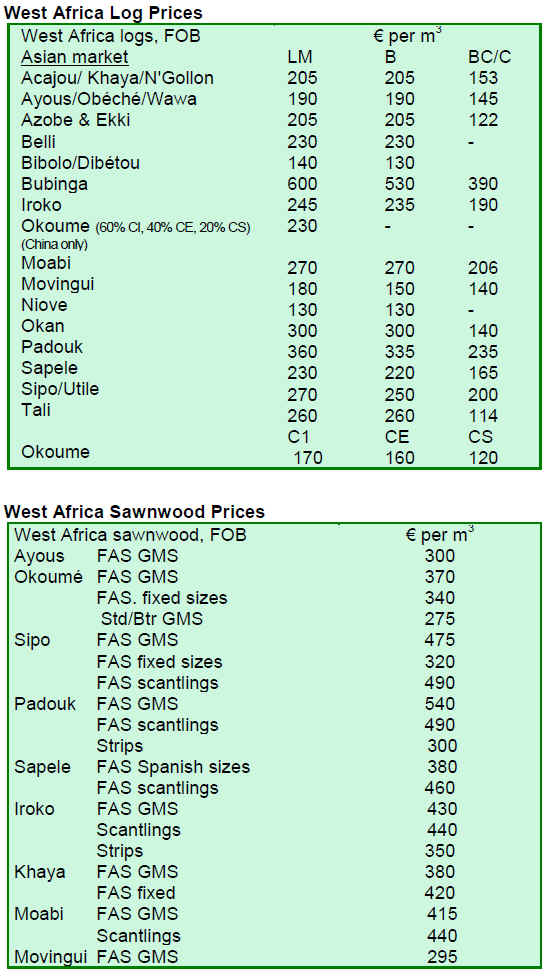
2. GHANA
First quarter wood product contracts rose 25%
Permits for a total contract volume of 118,000 cu.m of wood products were approved and processed in Ghana during the first quarter of 2010, up 25% compared to the fourth quarter in 2009. There are no recorded applications for the furniture exports in the period under review.
All the major wood products experienced some growth in volume, except sawnwood and rotary veneer which slipped marginally in comparison to the previous quarter.
There were significant increases in export volumes of plywood (51%), sliced veneer (86%), poles/billets/logs (31%) and processed lumber/mouldings (160%) compared to the fourth quarter of 2009.
Sawnwood continued to be the leading export product accounting for 38% of the total export volume in the first quarter of 2010.
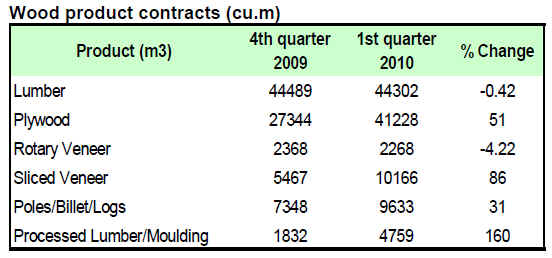
Contract prices reach GSP minimum level
Wood product prices especially for sawnwood improved in the first quarter of 2010. Most contract prices were at the minimum of the Guiding Selling Price (GSP).
Prices of mahogany (Khaya ivorensis) sawnwood advanced significantly from the previous quarter reaching US$750-US$820 per cu.m and with a few contracts gaining US$850 per cu.m during the first quarter of 2010.
There were no applications for furniture part exports in the quarter under review. Analysts say, this was probably because the main furniture export company, Scanstyle Mim Limited, has been concentrating on domestic sales.
Other West African countries continue to be the main market for plywood from Ghana accounting for about 90% of the total plywood exports. Unlike in the previous quarter, almost all plywood contract prices were at the minimum GSP during the quarter under review.
Steep rise in utility tariff
Ghana's Public Utility Regulatory Commission sharply raised the price of electricity and water for the first time in over two years, on the ground that utility companies needed cash to improve their services. The tariff hikes were substantial up 89% for electricity and 36% for water.
According to analysts, these will inevitably lead to a corresponding surge in the prices of goods, including timber products, as producers have no option than to pass on increasing costs to the consumers.
Tariff hike worries Ghana industry
The Ghana Timber Millers Association (GTMO) has added its voice to others who opposite the utility tariff increase.
GTMO describes the tariff increase as burdensome to the local timber industry which is already suffering from declining export demand and falling prices.
The spokesman of GTMO said: "It is certain that the new tariff would impact negatively on the cost of production since our production lines depend heavily on water and electricity".
GTMO called on the government to quickly act for a mutually acceptable deal by engaging the utility companies, the Public Utility Regulatory Commission and the business community.
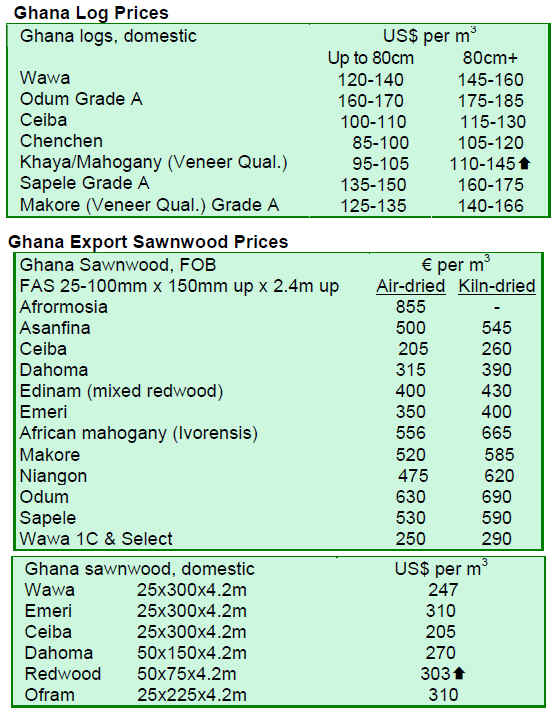
3.
MALAYSIA
Wood product prices remain flat
Wood product prices in Malaysia remained mostly unchanged during the last fortnight as European timber importers were not actively buying while waiting to see how the continuing European debt crises are affecting business. European buyers fear that there will be other EU countries with debts as bad as in Greece.
The continuing European debt crisis and high unemployment in the US have resulted in cautious purchasing from the importers. However, the Chinese market remains vibrant and offers good opportunities for timber exporters.
MTC eyes Jordan for increased timber exports
According to the Malaysian Timber Council (MTC), Malaysian timber product exports to Jordan are expected to increase by 10% this year. MTC recently organised a trade mission to Jordan with 13 Malaysian timber companies participating.
Trade between Malaysia and Jordan amounted to US$188 million in 2009, according to statistics from the Malaysian embassy in Jordan.
Jordan imported timber and wood products worth only US$3 million from Malaysia back in 1998. Since then, imports have rose steadily to US$32 million in 2007, US$41 million in 2008 and US$48 million in 2009.
Malaysian timber and timber product exports to the Middle-East reached US$508 million in year 2009. Jordan is the fifth largest importer of Malaysian timber products in the region after the UAE, Yemen, Saudi Arabia and Egypt.
Furniture buying mission by Japanese retailer
Maruni Furnishing Inc., a high quality wooden furniture and furniture products retailer in Japan, reportedly considers Malaysia as an attractive furniture supplier. The company made a buying mission to Malaysia recently.
In recent years, Malaysian furniture exports have been increasing to Japan, where China, Vietnam and Thailand have been the main exporting countries.
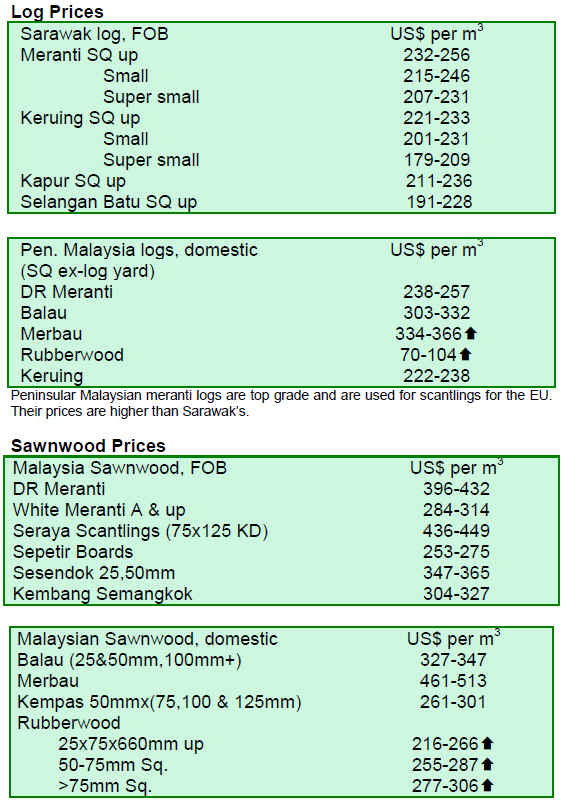
4.
INDONESIA
Moratorium on conversion of natural forests and peatlands
Indonesia announced a 2-year moratorium on new permits to convert natural forests and peatlands. The moratorium will take effect from the beginning of 2011.
Any permits granted for agriculture, plantations and mining before 2011, will not be affected by the moratorium. The Indonesian Ministry of Forestry pointed out that no permits to convert natural forests or peatlands have been issued since 2009.
The moratorium will not affect the operations of industrial timber estates and forest concession development programmes. Among these programmes are Societal Forest Development, Village Forest Development, Forest and Land Rehabilitation, Concession Restoration and Partnership Forest Development.
From 2011, businesses in agriculture, plantation and mining sectors will be permitted to extend their operations only to degraded forests or idle land. The National Land Bureau (BPN) has identified 12 million hectares of idle land and 40 million hectares of degraded forests for this purpose.
The moratorium is a measure to be taken in the context of the US$1 billion partnership agreement between Norway and Indonesia for forest conservation projects in Indonesia including under the framework of the Reduce Emissions from Deforestation and Forest Degradation (REDD) Plus. The agreement could be extended after an evaluation in 2013.
The moratorium will contribute to achieving the target set by the Indonesian government to reduce greenhouse gas emissions by 26% before 2020.
Government¡¯s action plan
The 2-year moratorium will have wide ranging effects on a number of provinces across Indonesia, including Riau, Jambi and Papua. In Riau province alone, the moratorium will protect up to 700,000 hectares of natural forest.
The Indonesian government will adopt a 9-point action plan to ensure the successful implementation of the partnership agreement and moratorium. The action plan entails setting up a forum to communicate and address concerns regarding the moratorium within the private sector. In addition, consultations at federal and regional levels will be held to create support and synergy between the federal government and local governments.
There are wide spread concerns among the industry and civil society on how to ensure the wood supply. In this regard, the issue of raw material supply for the Indonesian timber products industry in a sustainable way must be addressed, say analysts.
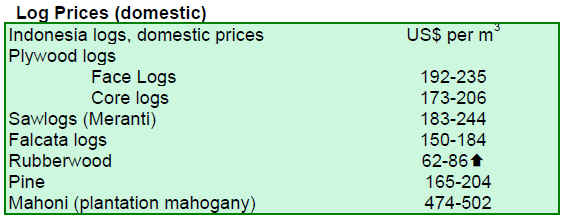
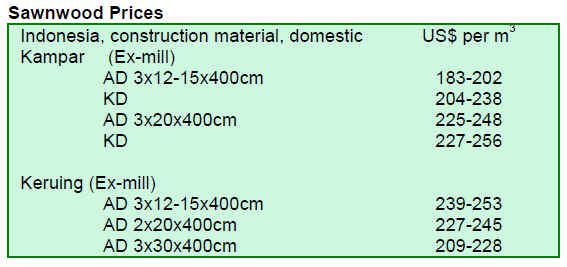
5.
MYANMAR
Sluggish teak and pyinkado market
The market for teak and other hardwoods is reported to be sluggish. Civil unrest in Thailand has had a negative impact on trade with the country. In addition, exports of Myanmar teak and pyinkado to India seem to be easing after the brisk trade experienced in May.
The Myanmar Timber Enterprise did not raise teak or pyinkado prices in May and there are no indications that it will do so any time soon, say analysts.
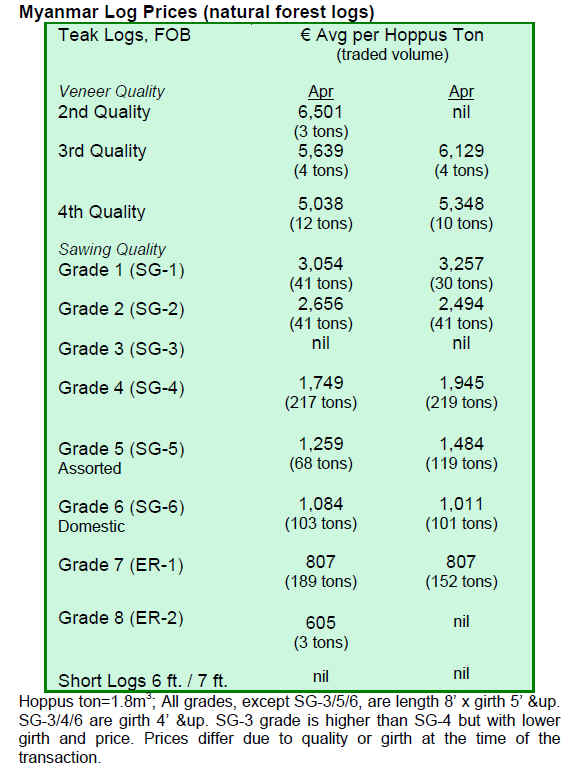
6. INDIA
Indian economy on strong footing
In the first quarter of 2010, India¡¯s GDP continued to grow for the fourth consecutive quarter. In January ¨C March 2010, GDP surged 8.6 % compared to the same period last year.
The manufacturing sector expanded 16.8% in the last quarter of the 2009 bringing annual growth for the 2009 to 10.8 %.
Exports, another positive indicator for the India¡¯s growth, rose for the sixth consecutive month to US$17 billion in April, up 36% over April last year.
On the back of this positive economic performance, 200-300 towns in India are likely to grow to mega cities in the next 10 years. These cities will be much cheaper than Mumbai and Delhi and the housing market is flourishing in these satellite towns.
Sandalwood gets attention
Sandalwood (Santalum album) is the most popular fragrant wood species world wide. The plantation production of sandalwood is spreading in India as well as in other Asian countries like Vietnam, Thailand, Indonesia and Sri Lanka.
State governments in India such as Kerala, Karnataka, Tamil Nadu and Andhra are plying a critical role in promoting the planting of sandalwood in government land. These state governments are also encouraging the private sector to establish plantations of sandalwood. If these efforts succeed, sandalwood may be removed from the list of endangered species in the future and thus will help maintain the perfumery and handicraft industries associated with this wood.
According to reports, there is a great potential to expand the plantations under sandalwood. The government needs to remove all constraints for investment in new sandalwood plantations and promote its planting and management by developing guidelines. To increase the economic value of sandalwood, new end-uses need to be sought and supplies must be ensured.
Madhya Pradesh in North and Mizhoram in North East have taken the lead in promoting and growing sandalwood in India.
Panel industry exhibitions
Panelexpo 2010 will take place in National Small Industries exhibition ground, instead of Pragati Maidan announced earlier. The dates for the expo are 1-4 December 2010. For more information visit: http://www.panelexpoindia.com/
Details of Delhiwood 2011 have also been announced and it will be held from 17th February 2011.
These fairs are considered to be very important for the growth of the Indian panel industry in both the domestic and international markets.
Import outlook
South West Monsoon is expected to begin soon and thus will cause a break in log sourcing in Western India. Sawmills have started to fill stocks to maintain production in next four months.
Presently, the flow of logs is still good and sales are brisk. The buyers are resisting higher prices.
The low level of log imports recorded in March is over and teak supply from Myamar is reported to be good. There is shortage of Sal and Gurjan logs in the market and this has stimulated demand for other species such as Kapur, Merbau, and Rengas.
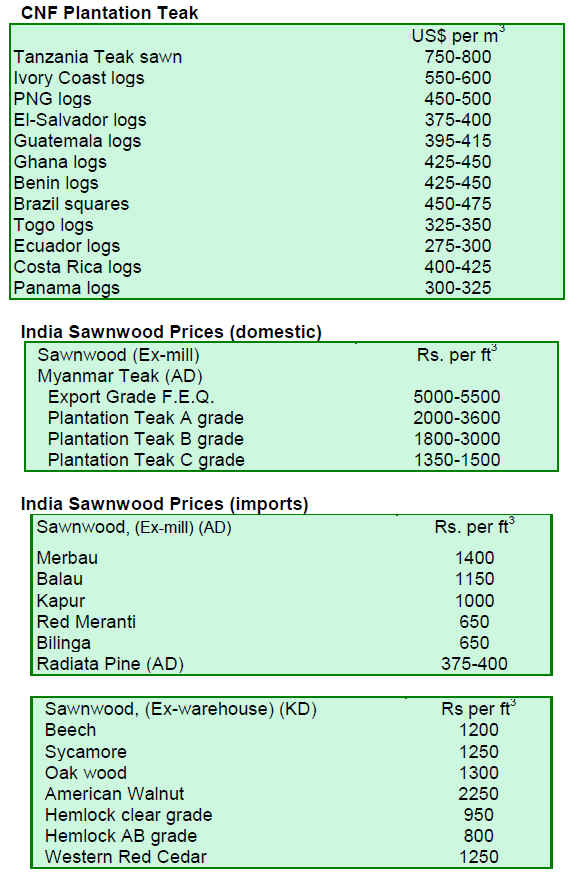
7. BRAZIL
Surge in wood exports from Minas Gerais
Exports of timber and wood products from Minas Gerais totalled US$243 million in January-April 2010. The export value is 88% higher compared to the same period in 2009 according to the Ministry of Development, Industry and Foreign Trade / Secretariat of Foreign Trade (MDIC / Secex).
In terms of volume, the timber and wood product exports were 381 tonnes in January-April 2009 and 410 tonnes in the same period this year, representing a 7.8% increase. The agribusiness sector exports in general experienced growth in the period under review.
According to statistics by the Agricultural Economics and Policy Superintendence (SPEA) of the Secretary of Agriculture, Livestock and Supply of Minas Gerais (SEAPA), the timber and wood product sector was ranked the second largest agribusiness exporter in the state with a 12% share of the total agribusiness exports.
The growth in exports of timber and wood products from Minas Gerais in international markets is due to the vast extension of planted forests state wide. Between 2004 and 2008, the total planted forest area in the state expanded 20%, to 1.4 million hectares.
The timber and wood product exports have good prospects for growth as the global economy recovers. In addition, forest product certification is seen as an opportunity to expand markets for wood products as consumers in the main markets are becoming increasingly concerned about the environment.
Teak as potential plantation species
The Forestry branch of the Brazilian Agricultural Research Corporation (Embrapa) Embrapa-Floresta and Embrapa Mato Grosso recently held a workshop on teak which is considered as potential species for forest plantations in Brazil. The traditional plantation species in Brazil are pine and eucalyptus.
The workshop promoted scientific-technical collaboration and discussed issues such as silviculture, economics, management, health and genetics. A genetic improvement programme for teak was one of the topics considered. The workshop participants were researchers, professors, foresters and businessmen.
According to the Brazilian Association of Forest Plantation Producers (ABRAF), the total teak commercial plantation area exceeded 65,000 hectares in 2009. Currently, Mato Grosso is the state with the largest teak plantation area in Brazil. However, Brazil has several geographic regions with climate and soil conditions suitable for teak.
Drawbacks in logging control systems
An investigation conducted by the Federal Police shows that logging control system established by the government has become ineffective over the years. Fictitious forest management plans and clear cutting authorization as well as fraudulent forest transport documents and trade in forest credits have been some of the practices used by violators involved in trade in illegal timber.
The Computerized Forest Products Trade and Transport System (Sisflora) was created in 2006 to replace the Forest Products Transport Authorization. This state level control system is in operation in Mato Grosso, Par¨¢, Rondônia and Maranhão. There is also the federal system of forest control, the Document of Forest Origin (DOF), which also has suffered from several drawbacks.
The computerised forest control system has been a major breakthrough, but it needs more transparency and adaptation to the current forest administration.
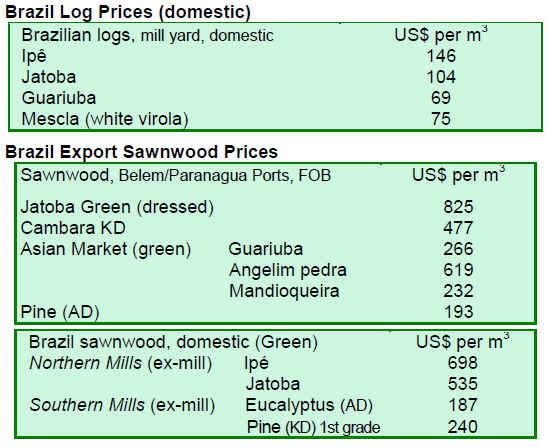
8.
PERU
Peru acts on CITES commitment
In the previous meeting of the Convention on International Trade in Endangered Species of Fauna and Flora (CITES) held in Doha, Peru committed to improve the current forestry information system for mahogany (Swietenia macrophylla) and cedar (Cedrela odorata).
The General Directorate of Forestry and Wildlife (DGFF) of the Ministry of Agriculture is assigned to be the implementing authority to address the CITES requirements. The development process is supported by various international institutions. The work is scheduled to be completed in September 2010.
New forest law to Congress in July
According to the Minister of Environment, the draft of "Law of Forestry and Wildlife" will be presented to the Presidency of the Council of Ministers in the second week of June and to the Congress in July.
The draft law designates the Ministry of Environment as the state agency responsible for authorising land use reformation throughout the Peruvian Amazon. The Ministry will also be the authority issuing permission to change forest land use to other uses. The Minister says that the new forestry law focuses on economic and social investment projects on forests.
According to some experts, the draft Forestry Law should be supported by a policy that facilitates the creation of a land market in the Amazon. This market should aim at bringing more than five million hectares of deforested land for sale or creating partnerships between local people and reforestation investors.
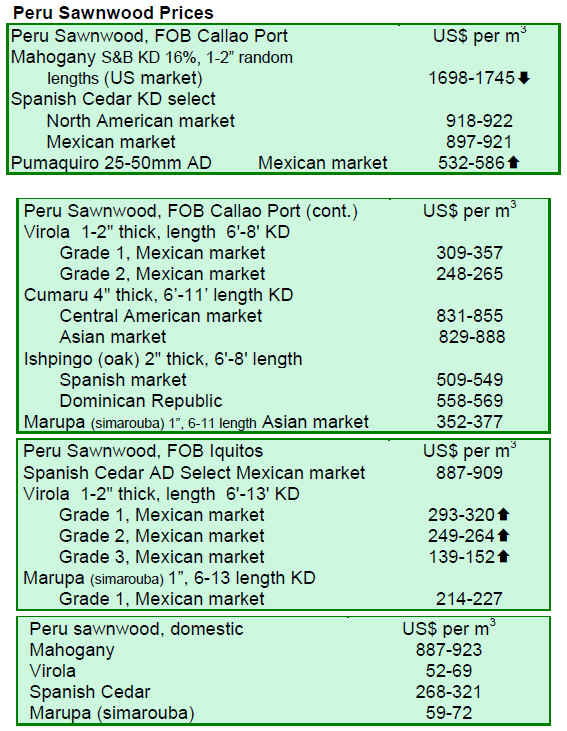
9.
Guyana
Market trends
During the period under review, log prices for all main species, i.e. Greenheart, Purpleheart and Mora made some gains.
Sawnwood prices for rough sawn (undressed) prime grade Greenheart rose while prices in other grades retreated. Mora (undressed) lumber prices remained relatively stable for this period.
Dressed Greenheart showed strong price gains for this fortnight period reaching US$1060 per cu.m, while dressed Purpleheart prices slipped.
Splitwood and roundwood contributed positively to the total export earnings for this fortnight period. Main export destinations were the USA (piles), the Caribbean (poles and posts) and Mauritius (splitwood).
Outdoor garden furniture made from Guyana¡¯s Locust (trade name: Jatoba, Courbaril) showed brisk trade especially to the UK market during the period under review. Other products including mouldings, indoor furniture, spindles and windows all contributed to the export performance of the timber sector.
Guyanese furniture showcased at international furniture exhibition
The International Contemporary Furniture Fair 2010 was held in New York in May 2010.
New Caribbean designs were displayed collectively by 21 artisans from eight countries. Guyana showcased brightly coloured chairs made from kufu vine produced by Liana Cane, a Guyanese furniture manufacturer devoted to renewable materials.

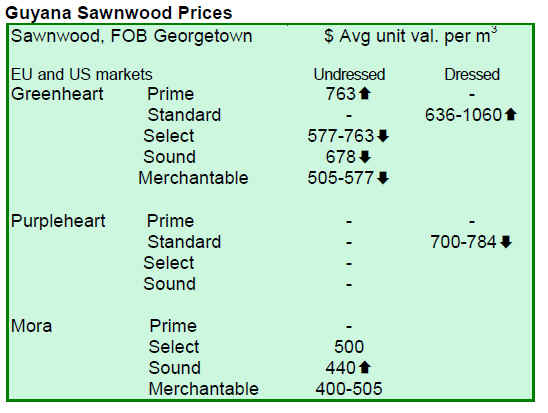
Related News:
|